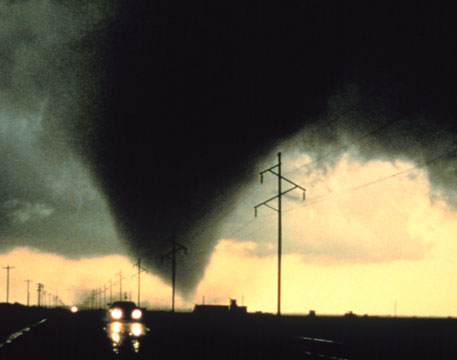Wooden Tornado Shelter Withstands High Winds
Wooden Tornado Shelter Withstands High Winds


Deadly tornados have more homeowners building safe rooms within their homes. Image: Harald Richter, NOAA Photo Library / Wikimedia Commons
Tornadoes wreak destruction across the U.S. every year, killing or injuring hundreds of people and causing millions of dollars in property damage. Some climate experts agree that climate change will increase the frequency and severity of these storms in coming years, putting more people in harm’s way.
As a result, more homeowners are installing “safe rooms” in their homes. These shelters are made from steel or reinforced concrete and are typically located in the basement or under the garage floor.
The downside is the cost. Installing a safe room can cost as much as $15,000 or more, which makes many people decide to take their chances with the weather.
Soon, however, a more affordable safe room may be on the market, made from basic, low-cost construction material: wood.
A Wood Tornado Shelter?
That’s right, engineers at Forest Products Laboratory (FPL) in Madison, WI, have built an 8-foot by 8-foot safe room prototype out of wood that can withstand winds up to 250 mph.
Robert Falk is the lead scientist on the project. The construction concept is based on nail-laminating 2-inch by 8-inch lumber into a tongue-and-groove beam that can be easily carried into an existing garage or basement. These beams are then stacked into a wall to the height needed. Plywood is then attached, further reinforcing the wall. “The interlocking design makes constructing the wall easy and results in a layered system that effectively dissipates the energy of debris impact,” says Falk.
Falk and his engineers tested the energy of debris impact using a debris cannon. The impact tests meet the ICC-500 standard and are conducted at a level commensurate with a 250-mph wind speed: A 15-pound, 2-inch by 4-inch missile fired at 100 mph).
“The design easily passes the impact test,” says Falk. “In fact, it took six cannon shots [all clustered within about 18 inches of each other] to fail our latest design per the criteria of ICC-500. Only the plywood layer cracked and no debris was generated. This is a testament to the energy dissipation characteristics of wood and wood construction.”
This current model of the safe room is constructed from readily available, low-cost building materials, including construction-grade two by eights, three-quarter-inch CDX plywood, nails, and construction adhesive. Falk is trying to further reduce costs by optimizing fastener and adhesive placement, as well as sheathing type. He is also designing the connection system to secure the room to a concrete slab.
“We expect to have a full-size safe room ready soon for lateral wind load and impact testing in the next few months,” he adds. “This should verify the wind load capacity of the design as well as connection performance.
Saving Lives
Falk envisions having online blueprints that can be downloaded so do-it-yourselfers can build their own shelters. “They buy the lumber, take it home, and put it together,” says Falk. “That’s an important aspect. By providing an economical and easy-to-build safe room, we will increase the number of people who can afford and install one.” Another option is providing a kit priced at about $3,000 to $4,000 for wood and materials, including a steel door.
Falk is also collaborating with a large wood-products manufacturer to investigate different engineered wood products for a safe-room door. He hopes they can build a wood storm door that will be more economic than currently available steel doors.
Robert Bonnie, the U.S. Department of Agriculture’s undersecretary for natural resources and the environment, is excited about FPL’s work. “This research is critically important, not only for the direct use of providing safe shelters for people in tornadoes, but also for creating a vibrant wood-products industry,” he says.
Mark Crawford is an independent writer.
By providing an economical and easy-to-build safe room, we will increase the number of people who can afford and install oneRobert Falk, lead scientist, Forest Product Laboratory





